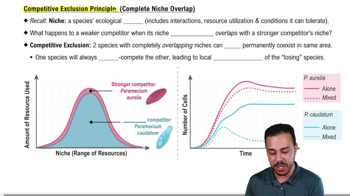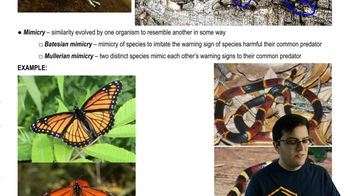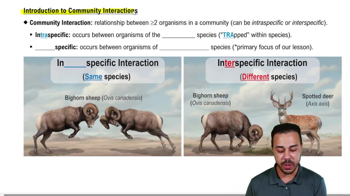Table of contents
- 1. Introduction to Biology2h 42m
- 2. Chemistry3h 40m
- 3. Water1h 26m
- 4. Biomolecules2h 23m
- 5. Cell Components2h 26m
- 6. The Membrane2h 31m
- 7. Energy and Metabolism2h 0m
- 8. Respiration2h 40m
- 9. Photosynthesis2h 49m
- 10. Cell Signaling59m
- 11. Cell Division2h 47m
- 12. Meiosis2h 0m
- 13. Mendelian Genetics4h 44m
- Introduction to Mendel's Experiments7m
- Genotype vs. Phenotype17m
- Punnett Squares13m
- Mendel's Experiments26m
- Mendel's Laws18m
- Monohybrid Crosses19m
- Test Crosses14m
- Dihybrid Crosses20m
- Punnett Square Probability26m
- Incomplete Dominance vs. Codominance20m
- Epistasis7m
- Non-Mendelian Genetics12m
- Pedigrees6m
- Autosomal Inheritance21m
- Sex-Linked Inheritance43m
- X-Inactivation9m
- 14. DNA Synthesis2h 27m
- 15. Gene Expression3h 20m
- 16. Regulation of Expression3h 31m
- Introduction to Regulation of Gene Expression13m
- Prokaryotic Gene Regulation via Operons27m
- The Lac Operon21m
- Glucose's Impact on Lac Operon25m
- The Trp Operon20m
- Review of the Lac Operon & Trp Operon11m
- Introduction to Eukaryotic Gene Regulation9m
- Eukaryotic Chromatin Modifications16m
- Eukaryotic Transcriptional Control22m
- Eukaryotic Post-Transcriptional Regulation28m
- Eukaryotic Post-Translational Regulation13m
- 17. Viruses37m
- 18. Biotechnology2h 58m
- 19. Genomics17m
- 20. Development1h 5m
- 21. Evolution3h 1m
- 22. Evolution of Populations3h 52m
- 23. Speciation1h 37m
- 24. History of Life on Earth2h 6m
- 25. Phylogeny2h 31m
- 26. Prokaryotes4h 59m
- 27. Protists1h 12m
- 28. Plants1h 22m
- 29. Fungi36m
- 30. Overview of Animals34m
- 31. Invertebrates1h 2m
- 32. Vertebrates50m
- 33. Plant Anatomy1h 3m
- 34. Vascular Plant Transport1h 2m
- 35. Soil37m
- 36. Plant Reproduction47m
- 37. Plant Sensation and Response1h 9m
- 38. Animal Form and Function1h 19m
- 39. Digestive System1h 10m
- 40. Circulatory System1h 57m
- 41. Immune System1h 12m
- 42. Osmoregulation and Excretion50m
- 43. Endocrine System1h 4m
- 44. Animal Reproduction1h 2m
- 45. Nervous System1h 55m
- 46. Sensory Systems46m
- 47. Muscle Systems23m
- 48. Ecology3h 11m
- Introduction to Ecology20m
- Biogeography14m
- Earth's Climate Patterns50m
- Introduction to Terrestrial Biomes10m
- Terrestrial Biomes: Near Equator13m
- Terrestrial Biomes: Temperate Regions10m
- Terrestrial Biomes: Northern Regions15m
- Introduction to Aquatic Biomes27m
- Freshwater Aquatic Biomes14m
- Marine Aquatic Biomes13m
- 49. Animal Behavior28m
- 50. Population Ecology3h 41m
- Introduction to Population Ecology28m
- Population Sampling Methods23m
- Life History12m
- Population Demography17m
- Factors Limiting Population Growth14m
- Introduction to Population Growth Models22m
- Linear Population Growth6m
- Exponential Population Growth29m
- Logistic Population Growth32m
- r/K Selection10m
- The Human Population22m
- 51. Community Ecology2h 46m
- Introduction to Community Ecology2m
- Introduction to Community Interactions9m
- Community Interactions: Competition (-/-)38m
- Community Interactions: Exploitation (+/-)23m
- Community Interactions: Mutualism (+/+) & Commensalism (+/0)9m
- Community Structure35m
- Community Dynamics26m
- Geographic Impact on Communities21m
- 52. Ecosystems2h 36m
- 53. Conservation Biology24m
51. Community Ecology
Introduction to Community Interactions
Problem 2`
Textbook Question
The principle of competitive exclusion states that
a. Two species cannot coexist in the same habitat.
b. Competition between two species always causes extinction or emigration of one species.
c. Two species that have exactly the same niche cannot coexist in a community.
d. Two species will stop reproducing until one species leaves the habitat.
 Verified step by step guidance
Verified step by step guidance1
Understand the principle of competitive exclusion, which is a concept in ecology that describes the outcome when two species compete for the same resources.
Recognize that the principle is based on the idea that two species cannot occupy the same niche in a community if they are competing for identical resources.
Consider the implications of this principle: if two species have identical niches, one will outcompete the other, leading to the exclusion of the less competitive species.
Evaluate the options given in the problem: a) two species cannot coexist in the same habitat, b) competition between two species always causes extinction or emigration of one species, c) two species that have exactly the same niche cannot coexist in a community, d) two species will stop reproducing until one species leaves the habitat.
Identify the option that aligns with the principle of competitive exclusion, which is that two species with exactly the same niche cannot coexist in a community, as one will outcompete the other.
 Verified video answer for a similar problem:
Verified video answer for a similar problem:This video solution was recommended by our tutors as helpful for the problem above
Video duration:
2mPlay a video:
Was this helpful?
Key Concepts
Here are the essential concepts you must grasp in order to answer the question correctly.
Competitive Exclusion Principle
The competitive exclusion principle, also known as Gause's Law, posits that two species competing for the exact same resources cannot stably coexist. If two species have identical niches, one will outcompete the other, leading to the latter's extinction or emigration. This principle highlights the importance of niche differentiation in maintaining biodiversity.
Recommended video:
Guided course

Competitive Exclusion Principle (Complete Niche Overlap)
Ecological Niche
An ecological niche refers to the role and position a species has in its environment, including all its interactions with biotic and abiotic factors. It encompasses how a species obtains resources, its behavior, and its contribution to the ecosystem. Understanding niches is crucial for grasping how species coexist and compete within communities.
Recommended video:
Guided course

Ecological Niches and Competition
Species Coexistence
Species coexistence involves multiple species living together in the same habitat without one driving the other to extinction. This is possible when species have different niches or when resources are abundant enough to reduce competition. Mechanisms like resource partitioning and temporal separation facilitate coexistence, allowing biodiversity to flourish.
Recommended video:

Biological Species Concept

 1:57m
1:57mWatch next
Master Introduction to Community Interactions with a bite sized video explanation from Jason
Start learningRelated Videos
Related Practice

















































